Object-Based Image Analysis of Ground-Penetrating Radar Data for Archaic Hearths
Abstract
:1. Introduction
1.1. Study Area
1.2. Archaic Period in the Southeastern United States
1.3. Ground-Penetrating Radar for Archaeology
2. Materials and Methods
2.1. Geophysical Survey
2.2. Ground-Penetrating Radar Data Processing
2.3. Archaeological Excavation
2.4. Object-Based Image Analysis
3. Results
3.1. GIS Model
3.2. Auger Testing
4. Discussion
5. Conclusions
Author Contributions
Funding
Acknowledgments
Conflicts of Interest
References
- Barceló, J.A. The birth and historical development of computational intelligence applications in archaeology. Archeol. e Calcolatori 2009, 20, 95–109. [Google Scholar]
- Puyol-Gruart, J. Computer science, artificial intelligence and archaeology. BAR Int. Ser. 1999, 757, 19–28. [Google Scholar]
- Verdonck, L.; De Smedt, P.; Verhegge, J. Making sense of anomalies: Practices and challenges in the archaeological interpretation of geophysical data. In Innovation in Near-Surface Geophysics, 1st ed.; Persico, R., Piro, S., Linford, N., Eds.; Elsevier: Amsterdam, The Netherlands, 2019; pp. 151–194. [Google Scholar] [CrossRef]
- Blaschke, T. Object based image analysis for remote sensing. ISPRS J. Photogramm. Remote Sens. 2010, 65, 2–16. [Google Scholar] [CrossRef] [Green Version]
- Blaschke, T.; Kelly, M.; Merschdorf, H. Object-based image analysis: Evolution, history, state of the art, and future vision. In Remotely Data Characterization, Classification, and Accuracies; Thenkabail, P.S., Ed.; CRC Press: Boca Raton, FL, USA, 2015; Volume 1, pp. 277–293. [Google Scholar] [CrossRef] [Green Version]
- Kamagata, N.; Akamatsu, Y.; Mori, M.; Li, Y.Q.; Hoshino, Y.; Hara, K. Comparison of pixel-based and object-based classifications of high resolution satellite data in urban fringe areas. In Proceedings of the 26th Asian Conference on Remote Sensing, Hanoi, Vietnam, 7–11 November 2005; Curran Associates, Inc.: Red Hook, NY, USA, 2005; Volume 3, pp. 1590–1595. [Google Scholar]
- Liu, D.; Xia, F. Assessing object-based classification: Advantages and limitations. Remote Sens. Lett. 2010, 1, 187–194. [Google Scholar] [CrossRef]
- Sevara, C.; Pregesbauer, M.; Doneus, M.; Verhoeven, G.; Trinks, I. Pixel versus object—A comparison of strategies for the semi-automated mapping of archaeological features using airborne laser scanning data. J. Archaeol. Sci. Rep. 2016, 5, 485–498. [Google Scholar] [CrossRef]
- Sibaruddin, H.I.; Shafri, H.Z.M.; Pradhan, B.; Haron, N.A. Comparison of pixel-based and object-based image classification techniques in extracting information from UAV imagery data. In IOP Conference Series: Earth and Environmental Science; IOP Publishing: Bristol, UK, 2018; Volume 169, p. 012098. [Google Scholar] [CrossRef]
- Verhagen, P.; Drăguţ, L. Object-based landform delineation and classification from DEMs for archaeological predictive mapping. J. Archaeol. Sci. 2012, 39, 698–703. [Google Scholar] [CrossRef]
- Xiaoxia, S.; Jixian, Z.; Zhengjun, L. A Comparison of Object-Oriented and Pixel-Based Classification Approaches Using Quickbird Imagery; Chinese Academy of Surveying and Mapping: Beijing, China, 2004. [Google Scholar]
- Kvamme, K. An Examination of Automated Archaeological Feature Recognition in Remotely Sensed Imagery. In Computational Approaches to Archaeological Spaces; Andrew, B., Lake, M., Eds.; Left Coast Press: Walnut Creek, CA, USA, 2013; pp. 53–68. [Google Scholar]
- Luo, L.; Wang, X.; Guo, H.; Lasaponara, R.; Zong, X.; Masini, N.; Wang, G.; Shi, P.; Khatteli, H.; Chen, F.; et al. Airborne and spaceborne remote sensing for archaeological and cultural heritage applications: A review of the century (1907–2017). Remote Sens. Environ. 2019, 232, 111280. [Google Scholar] [CrossRef]
- Minár, J.; Evans, I.S. Elementary forms for land surface segmentation: The theoretical basis of terrain analysis and geomorphological mapping. Geomorphology 2008, 95, 236–259. [Google Scholar] [CrossRef]
- Doctor, D.H.; Young, J.A. An Evaluation of Automated GIS Tools for Delineating Karst Sinkholes and Closed Depressions from 1-meter LIDAR-Derived Digital Elevation Data. In Proceedings of the 13th Multidisciplinary Conference on Sinkholes and the Engineering and Environmental Impacts of Karst, Carlsbad, Mexico, 6–10 May 2013; Land, L., Doctor, D.H., Stephenson, J.B., Eds.; National Cave and Karst Research Institute: Carlsbad, NM, USA, 2013; pp. 449–458. [Google Scholar] [CrossRef] [Green Version]
- Kobal, M.; Bertoncelj, I.; Pirotti, F.; Dakskobler, I.; Kutnar, L. Using lidar data to analyze sinkhole characteristics relevant for understory vegetation under forest cover—Case study of a high karst area in the Dinaric Mountains. PLoS ONE 2015, 10, e0122070. [Google Scholar] [CrossRef] [PubMed] [Green Version]
- Parise, M.; Pisano, L.; Zumpano, V. Detection and Characterization of Sinkholes through Integration of Field Surveys and Semi-automated Techniques. In Eurokarst 2018, Besançon: Advances in the Hydrogeology of Karst and Carbonate Reservoirs; Springer: Cham, Switzerland, 2020; pp. 3–9. [Google Scholar] [CrossRef]
- Šegina, E.; Benac, Č.; Rubinić, J.; Knez, M. Morphometric analyses of dolines—The problem of delineation and calculation of basic parameters. Acta Carsologica 2018, 47. [Google Scholar] [CrossRef]
- Shannon, J.C.; Moore, D.; Li, Y.; Olsen, C. LiDAR-based Sinkhole Detection and Mapping in Knox County, Tennessee. Pursuit J. Undergrad. Res. Univ. Tenn. 2019, 9, 1–23. [Google Scholar]
- Verbovšek, T.; Gabor, L. Morphometric properties of dolines in Matarsko podolje, SW Slovenia. Environ. Earth Sci. 2019, 78, 396. [Google Scholar] [CrossRef]
- Davis, D.S. Object-based image analysis: A review of developments and future directions of automated feature detection in landscape archaeology. Archaeol. Prospect. 2019, 26, 155–163. [Google Scholar] [CrossRef]
- Davis, D.S.; Sanger, M.C.; Lipo, C.P. Automated mound detection using lidar and object-based image analysis in Beaufort County, South Carolina. Southeast. Archaeol. 2019, 38, 23–37. [Google Scholar] [CrossRef]
- Freeland, T.; Heung, B.; Burley, D.V.; Clark, G.; Knudby, A. Automated feature extraction for prospection and analysis of monumental earthworks from aerial LiDAR in the Kingdom of Tonga. J. Archaeol. Sci. 2016, 69, 64–74. [Google Scholar] [CrossRef]
- Vogelaar, C. Using GIS Modelling as a Tool to Search for Late Pleistocene and Early Holocene Archaeology on Quadra Island, British Columbia. Master’s Thesis, University of Victoria, Victoria, BC, Canada, 2017. [Google Scholar]
- Dawson, R.A.; Petropoulos, G.P.; Toulios, L.; Srivastava, P.K. Mapping and monitoring of the land use/cover changes in the wider area of Itanos, Crete, using very high resolution EO imagery with specific interest in archaeological sites. Environ. Dev. Sustain. 2020, 22, 3433–3460. [Google Scholar] [CrossRef]
- Hay, G.J.; Castilla, G. Geographic Object-Based Image Analysis (GEOBIA): A new name for a new discipline. In Object-Based Image Analysis: Spatial Concepts for Knowledge-Driven Remote Sensing Applications, 1st ed.; Blaschke, T., Lang, S., Hay, G., Eds.; Springer: Berlin/Heidelberg, Germany, 2008; pp. 75–89. [Google Scholar] [CrossRef]
- Al-Nuaimy, W.; Huang, Y.; Nakhkash, M.; Fang, M.T.C.; Nguyen, V.T.; Eriksen, A. Automatic detection of buried utilities and solid objects with GPR using neural networks and pattern recognition. J. Appl. Geophys. 2000, 43, 157–165. [Google Scholar] [CrossRef]
- Bescoby, D.J.; Cawley, G.C.; Chroston, P.N. Enhanced interpretation of magnetic survey data using artificial neural networks: A case study from Butrint, southern Albania. Archaeol. Prospect. 2004, 11, 189–199. [Google Scholar] [CrossRef]
- Ernenwein, E.G. Integration of multidimensional archaeogeophysical data using supervised and unsupervised classification. Near Surf. Geophys. 2009, 7, 147–158. [Google Scholar] [CrossRef]
- Florio, G.; Lo Re, D. Terracing of potential fields by clustering methods. Geophysics 2018, 83, G47–G58. [Google Scholar] [CrossRef]
- Sheen, N.P.; Aspinall, A. A simulation of anomalies to aid the interpretation of magnetic data. BAR Int. Ser. 1995, 598, 57–63. [Google Scholar]
- Ward, W.O.; Wilkinson, P.B.; Chambers, J.E.; Oxby, L.S.; Bai, L. Distribution-based fuzzy clustering of electrical resistivity tomography images for interface detection. Geophys. J. Int. 2014, 197, 310–321. [Google Scholar] [CrossRef] [Green Version]
- Hegyi, A.; Vernica, M.M.; Drăguţ, L. An object-based approach to support the automatic delineation of magnetic anomalies. Archaeol. Prospect. 2019, 27, 3–12. [Google Scholar] [CrossRef]
- Pregesbauer, M.; Trinks, I.; Neubauer, W. An object oriented approach to automatic classification of archaeological features in magnetic prospection data. Near Surf. Geophys. 2014, 12, 651–656. [Google Scholar] [CrossRef]
- Salguero, F.; Prat, F.; Moreno, F.; Romero, S. Mean shift: A non-parametric algorithm for the segmentation of anomalies in geophysical images obtained from magnetic prospection data. Archaeometry 2011, 53, 642–659. [Google Scholar] [CrossRef]
- Linford, N.; Linford, P. The application of semi-automated vector identification to large scale archaeological data sets considering anomaly morphology. In Proceedings of the 12th International Conference of Archaeological Prospection, University of Bradford, Bradford, UK, 12–16 September 2017; Jennings, B., Gaffney, C., Sparrow, T., Gaffney, S., Eds.; Archaeopress Archaeology: Oxford, UK, 2017; p. 4919. [Google Scholar]
- Schmidt, A.; Tsetskhladze, G. Raster was yesterday: Using vector engines to process geophysical data. Archaeol. Prospect. 2013, 20, 59–65. [Google Scholar] [CrossRef]
- Middleton, M.; Schnur, T.; Sorjonen-Ward, P.; Hyvönen, E. Geological lineament interpretation using the object-based image analysis approach: Results of semi-automated analyses versus visual interpretation. In Geological Survey of Finland, Special Paper 57; Sarala, P., Ed.; Juvenes Print—Suomen Yliopistopaino Oy: Tampare, Finland, 2015; pp. 135–154. [Google Scholar]
- Seijmonsbergen, A.C.; Hengl, T.; Anders, N.S. Semi-automated identification and extraction of geomorphological features using digital elevation data. In Developments in Earth Surface Processes; Smith, M.J., Paron, P., Griffiths, J.S., Eds.; Elsevier: Amsterdam, The Netherlands, 2011; Volume 15, pp. 297–335. [Google Scholar] [CrossRef]
- Benthall, J.L. Archaeological Investigations at Davy Crockett Birthplace Historical Area; Department of Environment and Conservation, Division of Archaeology: Nashville, TN, USA, 1997; pp. 1–77, Unpublished work.
- Smith, S.D. Historical Background and Archaeological Testing of the Davy Crockett Birthplace State Historic Area, Greene County, Tennessee, Research Series No. 6; Tennessee Department of Conservation: Nashville, TN, USA, 1980; pp. 1–67.
- Rodgers, J. Geologic Map of East Tennessee with Explanatory Text; Bullentin 58, Part II; Tennessee Division of Geology: Nashville, TN, USA, 1953; pp. 1–168.
- Hardeman, W.D.; Miller, R.A.; Swingle, G.D. Geological Map of Tennessee; Tennessee Division of Geology: Nashville, TN, USA, 1966; east sheet.
- Soil Survey Staff, Natural Resources Conservation Service, United States Department of Agriculture. Web Soil Survey. Available online: http://websoilsurvey.sc.egov.usda.gov/ (accessed on 5 September 2019).
- Dalton-Carriger, J.N. New Perspectives on the Seventeenth-Century Protohistoric Period in East Tennessee: Redefining the Period through Glass Trade Bead and Ceramic Analyses. Ph.D. Dissertation, University of Tennessee, Knoxville, TN, USA, 2016; pp. 1–180. [Google Scholar]
- Hudson, C.M. The Southeastern Indians; University of Tennessee Press: Knoxville, TN, USA, 1976; pp. 34–119. [Google Scholar]
- Ward, H.T.; Davis, R.P., Jr. Time before History: The Archaeology of North. Carolina; The University of North Carolina Press: Chapel Hill, NC, USA, 1999; pp. 1–328. [Google Scholar]
- Anderson, D.G.; Sassaman, K.E. Early and middle Holocene periods, 9500–3750 BC. In Southeast Volume, Smithsonian Handbook of North American Indians; Fogleson, R.D., Ed.; Smithsonian Institution: Washington, DC, USA, 2004; pp. 87–100. [Google Scholar]
- Gibson, J.L. Navels of the Earth: Sedentism in Early Mound-Building Cultures in the Lower Mississippi Valley. World Archaeol. 2006, 38, 311–329. [Google Scholar] [CrossRef]
- Russo, M. Why we don’t believe in Archaic ceremonial mounds and why we should: The case from Florida. Southeast. Archaeol. 1994, 13, 93–109. [Google Scholar]
- Sassaman, K.E.; Rudolphi, W. Communities of practice in the early pottery traditions of the American Southeast. J. Anthropol. Res. 2001, 57, 407–425. [Google Scholar] [CrossRef]
- McIlhany, C.W. Archaeological Survey of the Middle Nolichucky River Basin of Northeastern Tennessee. Master’s Thesis, University of Tennessee, Knoxville, TN, USA, 1978; pp. 1–36, Unpublished work. [Google Scholar]
- Tennessee Division of Archaeology (TDOA); Nashville, TN, USA. Personal communication, 2020.
- Conyers, L.B. Interpreting Ground-Penetrating Radar for Archaeology; Left Coast Press: Walnut Creek, CA, USA, 2012; pp. 17–208. [Google Scholar] [CrossRef]
- Dojack, L. Ground Penetrating Radar Theory, Data Collection, Processing, and Interpretation: A Guide for Archaeologists; University of British Columbia: Vancouver, BC, Canada, 2012; p. 89. [Google Scholar] [CrossRef]
- Vaughan, C.J. Ground-penetrating radar surveys used in archaeological investigations. Geophysics 1986, 51, 595–604. [Google Scholar] [CrossRef]
- Neal, A. Ground-penetrating radar and its use in sedimentology: Principles, problems and progress. Earth Sci. Rev. 2004, 66, 261–330. [Google Scholar] [CrossRef]
- Smith, D.G.; Jol, H.M. Ground penetrating radar: Antenna frequencies and maximum probable depths of penetration in Quaternary sediments. J. Appl. Geophys. 1995, 33, 93–100. [Google Scholar] [CrossRef]
- Witten, A.J. Handbook of Geophysics and Archaeology; Equinox Publishing Limited: London, UK, 2006; pp. 214–271. [Google Scholar] [CrossRef]
- Kvamme, K.L. Geophysical surveys as landscape archaeology. Am. Antiq. 2003, 68, 435–457. [Google Scholar] [CrossRef]
- Kvamme, K.L. A Decade of Geophysics and Remote Sensing in North American Archaeology: Practices, Advances, and Trends. In Archaeological Remote Sensing in North America; McKinnon, D.P., Haley, B.S., Eds.; University of Alabama Press: Tuscaloosa, AL, USA, 2017; pp. 215–266. [Google Scholar]
- Thompson, V.D.; Arnold, P.J.; Pluckhahn, T.J.; Vanderwarker, A.M. Situating remote sensing in anthropological archaeology. Archaeol. Prospect. 2011, 62. [Google Scholar] [CrossRef]
- Vickers, R.S.; Dolphin, L.T.; Johnson, D. Archaeological investigations at Chaco Canyon using subsurface radar. In Remote Sensing Experiments in Cultural Resource Studies; Lyons, T.R., Ed.; National Park Service, U.S. Department of the Interior and University of New Mexico: Albuquerque, NM, USA, 1976; pp. 81–101. [Google Scholar]
- Ernenwein, E.G.; Kvamme, K.L. Data processing issues in large-area GPR surveys: Correcting trace misalignments, edge discontinuities and striping. Archaeol. Prospect. 2008, 15, 133–149. [Google Scholar] [CrossRef]
- Chapman, J.K. Comparison of Archeological Survey Techniques at Camp Lawton, a Civil War Prison Stockade. Master’s Thesis, Georgia Southern University, Statesboro, GA, USA, 2012. [Google Scholar]
- Jones, G. Geophysical investigation at the Falling Creek ironworks, an early industrial site in Virginia. Archaeol. Prospect. 2001, 8, 247–256. [Google Scholar] [CrossRef]
- Jones, G. Geophysical mapping of historic cemeteries. Tech. Briefs Hist. Archaeol. 2008, 3, 25–38. [Google Scholar]
- Patch, S.M.; Espenshade, C.T.; Lowry, S.; Severts, P. ‘No Terms but Unconditional Surrender’: Archaeological and Geophysical Assessment of the Fort Donelson Confederate Monument Landscape, Stewart County, Tennessee. Tenn. Archaeol. 2015, 7, 110–140. [Google Scholar]
- Thompson, V.D.; DePratter, C.B.; Thompson, A.D.R. A preliminary exploration of Santa Elena’s sixteenth century colonial landscape through shallow geophysics. J. Archaeol. Sci. Rep. 2016, 9, 178–190. [Google Scholar] [CrossRef] [Green Version]
- Bigman, D.P.; Lanzarone, P.M. Investigating construction history, labour investment and social change at Ocmulgee National Monument’s Mound A, Georgia, USA, using ground-penetrating radar. Archaeol. Prospect. 2014, 21, 213–224. [Google Scholar] [CrossRef]
- Menzer, J.G. Discovering Rock Features with Geophysical Exploration and Archaeological Testing at the Mississippian Pile Mound Site, Upper Cumberland Plateau, Tennessee. Master’s Thesis, East Tennessee State University, Johnson City, TN, USA, 2015. [Google Scholar]
- McNutt, C.H.; Franklin, J.D.; Henry, E.R. New perspectives on Mississippian occupations in western Tennessee and northwestern Mississippi: Recent chronological and geophysical investigations at Chucalissa (40SY1), Shelby County, Tennessee. Southeast. Archaeol. 2012, 31, 231–250. [Google Scholar] [CrossRef]
- Moore, P.A. A Geophysical Survey of the Kituhwa Mound (31SW2) and the Surrounding Area (31SW1), Swain County, North Carolina. Ph.D. Dissertation, University of Tennessee, Knoxville, TN, USA, 2009. [Google Scholar]
- Patch, S.M.; Lowry, S.; Pritchard, E. Two Examples from the Tennessee River Valley. In Archaeological Remote Sensing in North America: Innovative Techniques for Anthropological Applications; McKinnon, D.P., Haley, B.S., Eds.; University of Alabama Press: Tuscaloosa, AL, USA, 2017; p. 28. [Google Scholar]
- Seinfeld, D.M.; Bigman, D.P.; Stauffer, J.G.; Nowak, J.C. Mound building at Lake Jackson (8LE1), Tallahassee, Florida: New insights from ground penetrating radar. Southeast. Archaeol. 2015, 34, 220–236. [Google Scholar] [CrossRef]
- Schubert, A.; Horsley, T. Determining village extent and layout utilizing geophysical survey and excavation at the Mississippian site of Cane River, North Carolina. In Proceedings of the Presented at the 80th Annual Meeting of the Society for American Archaeology, San Francisco, CA, USA, 15–19 April 2015. [Google Scholar] [CrossRef]
- Horsley, T.; Wright, A.; Barrier, C. Prospecting for new questions: Integrating geophysics to define anthropological research objectives and inform excavation strategies at monumental sites. Archaeol. Prospect. 2014, 21, 75–86. [Google Scholar] [CrossRef] [Green Version]
- Thompson, V.D.; Marquardt, W.H.; Walker, K.J. A remote sensing perspective on shoreline modification, canal construction and household trajectories at pineland along Florida’s southwestern Gulf Coast. Archaeol. Prospect. 2014, 21, 59–73. [Google Scholar] [CrossRef]
- Hargrave, M.L.; Britt, T.; Reynolds, M.D. Magnetic evidence of ridge construction and use at Poverty Point. Am. Antiq. 2007, 72, 757–769. [Google Scholar] [CrossRef]
- Thompson, V.D.; DePratter, C.B.; Lulewicz, J.; Lulewicz, I.H.; Roberts Thompson, A.D.; Cramb, J.; Ritchison, B.T.; Colvin, M.H. The archaeology and remote sensing of Santa Elena’s four millennia of occupation. Remote Sens. 2018, 10, 248. [Google Scholar] [CrossRef] [Green Version]
- Aspinall, A.; Gaffney, C.; Conyers, L.B. Archaeological prospection—The first fifteen years. Archaeol. Prospect. 2008, 15, 241–245. [Google Scholar] [CrossRef]
- Conyers, L.B. Ground-penetrating Radar for Anthropological Research. Antiquity 2010, 84, 175–184. [Google Scholar] [CrossRef] [Green Version]
- Conyers, L.B.; Leckebusch, J. Geophysical archaeology research agendas for the future: Some ground-penetrating radar examples. Archaeol. Prospect. 2010, 17. [Google Scholar] [CrossRef]
- Ramsey, C.B. Bayesian analysis of radiocarbon dates. Radiocarbon 2009, 51, 337–360. [Google Scholar] [CrossRef] [Green Version]
- Reimer, P.J.; Bard, E.; Bayliss, A.; Beck, J.W.; Blackwell, P.G.; Ramsey, C.B.; Buck, C.E.; Cheng, H.; Edwards, R.L.; Friedrich, M.; et al. IntCal13 and Marine13 radiocarbon age calibration curves 0–50,000 years cal BP. Radiocarbon 2013, 55, 1869–1887. [Google Scholar] [CrossRef] [Green Version]
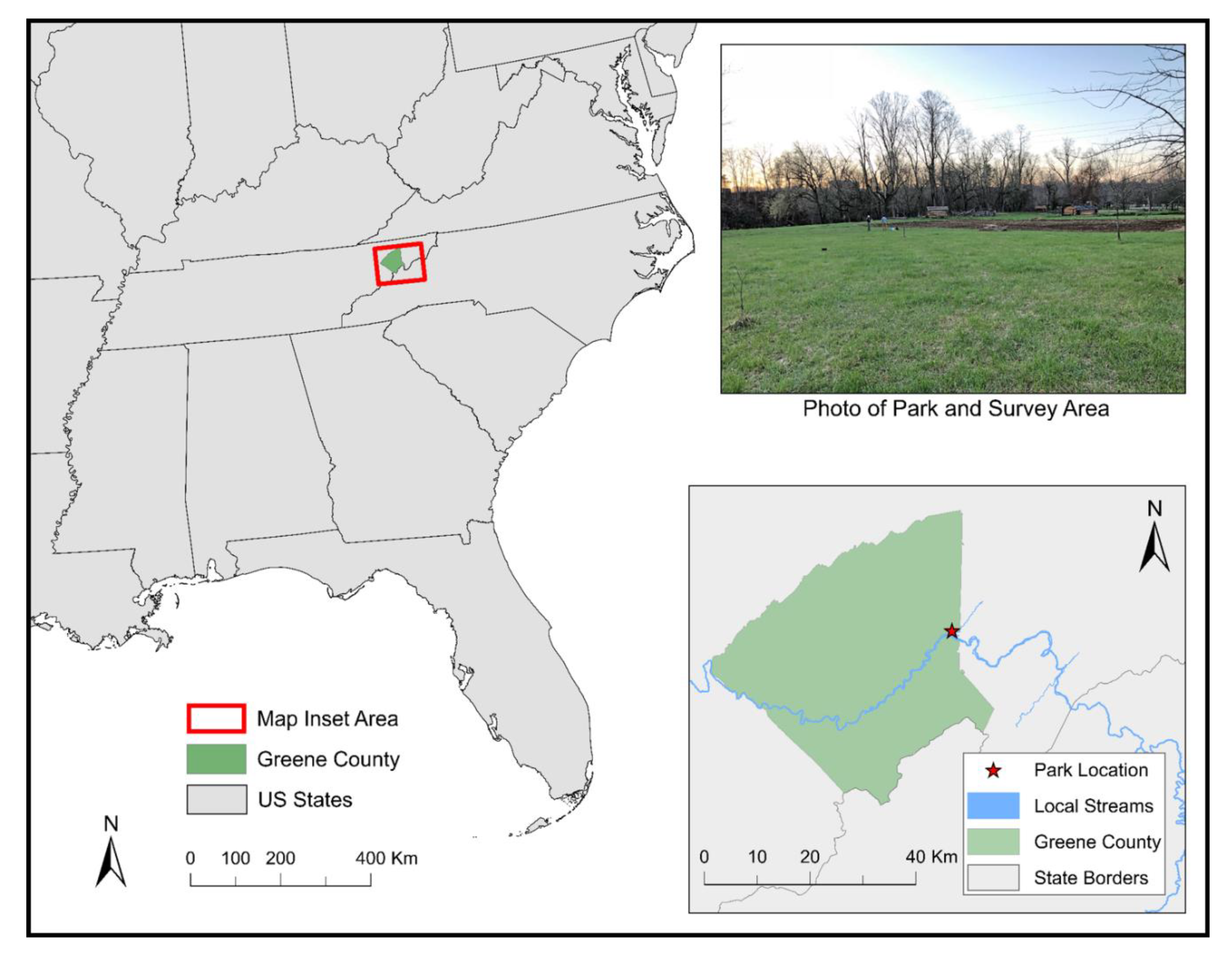
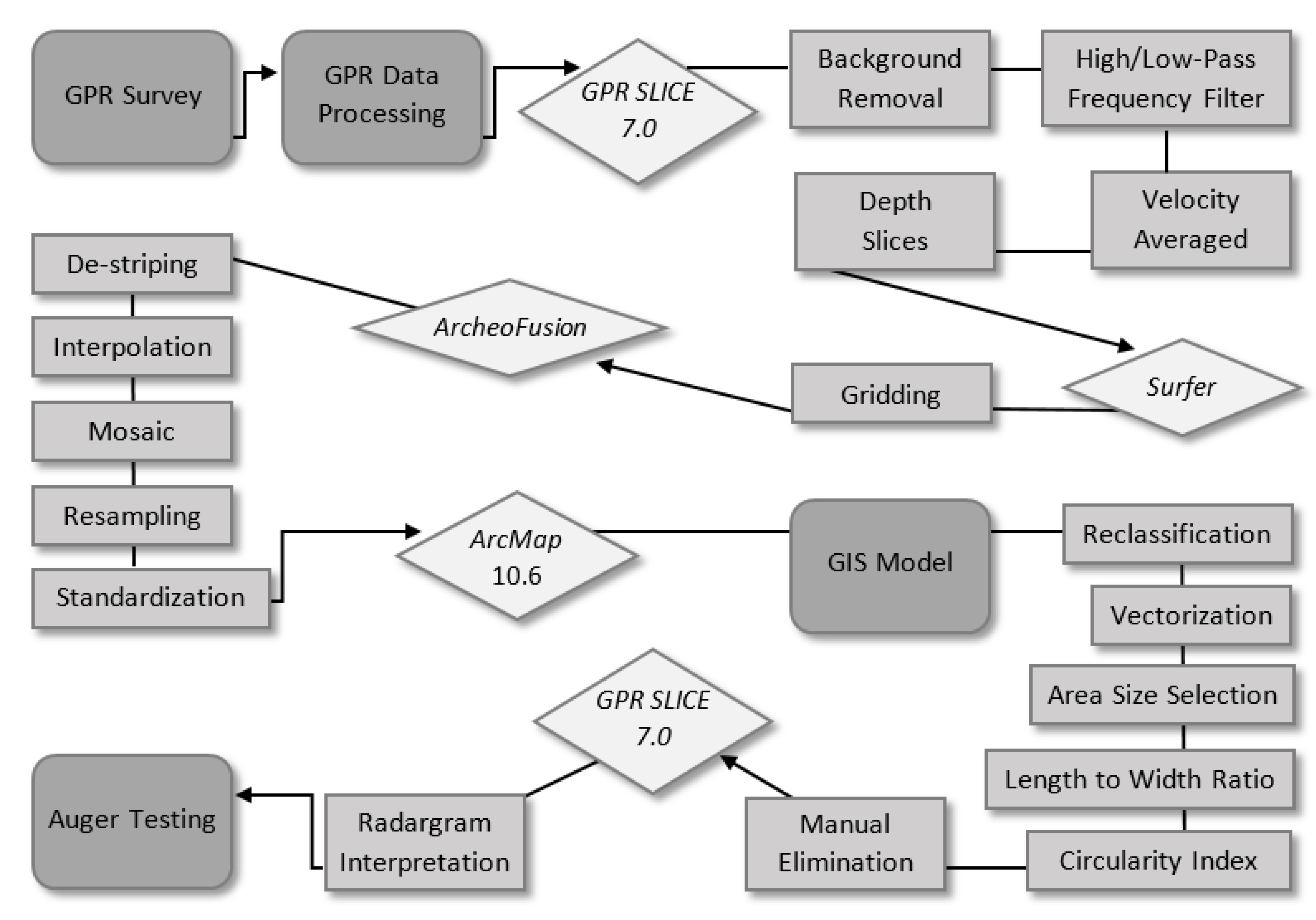
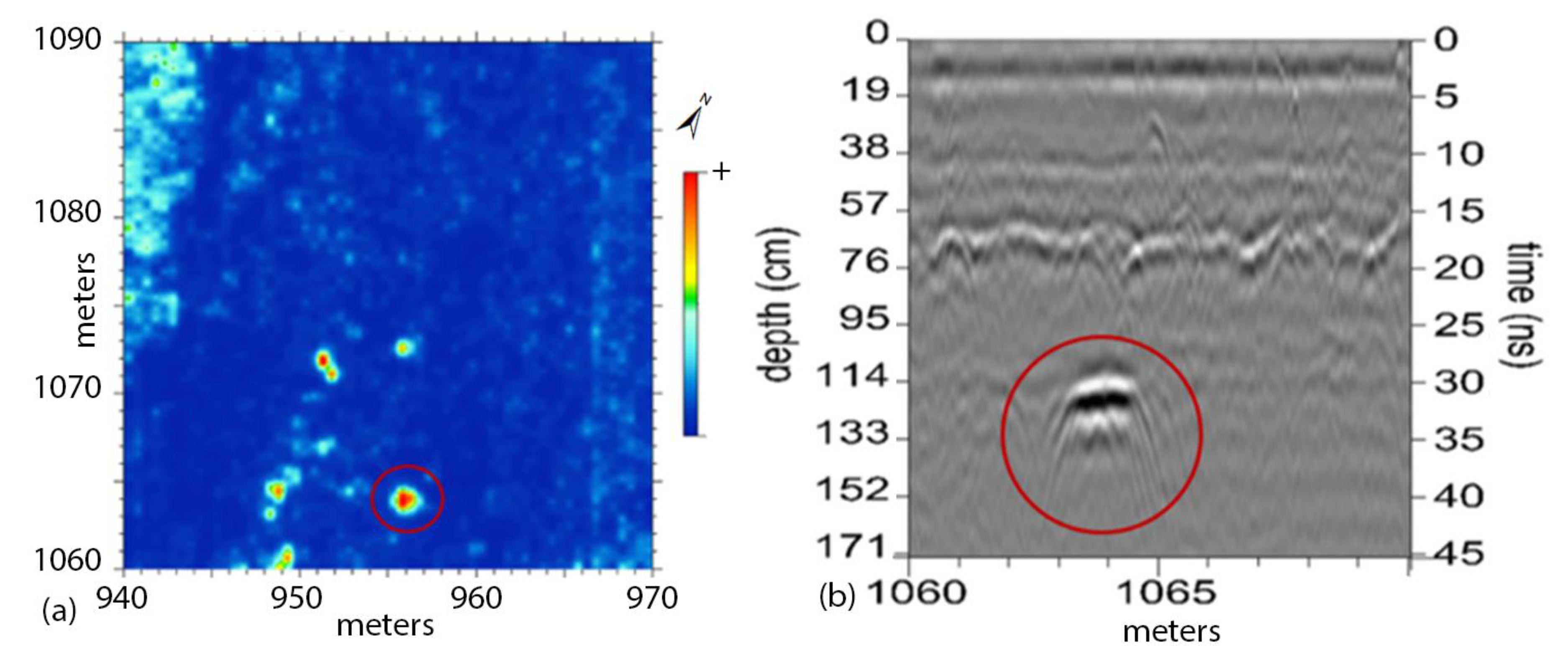
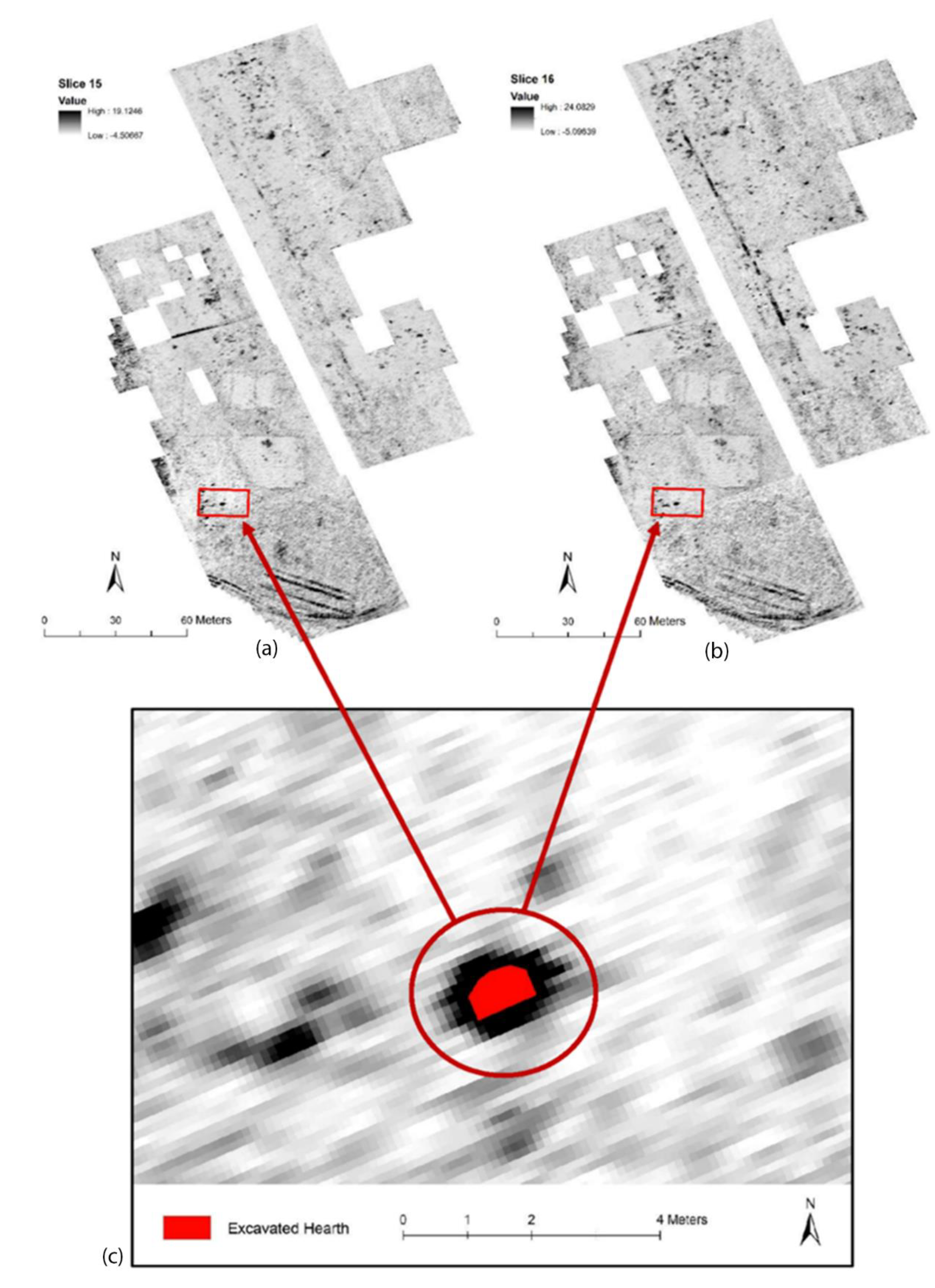
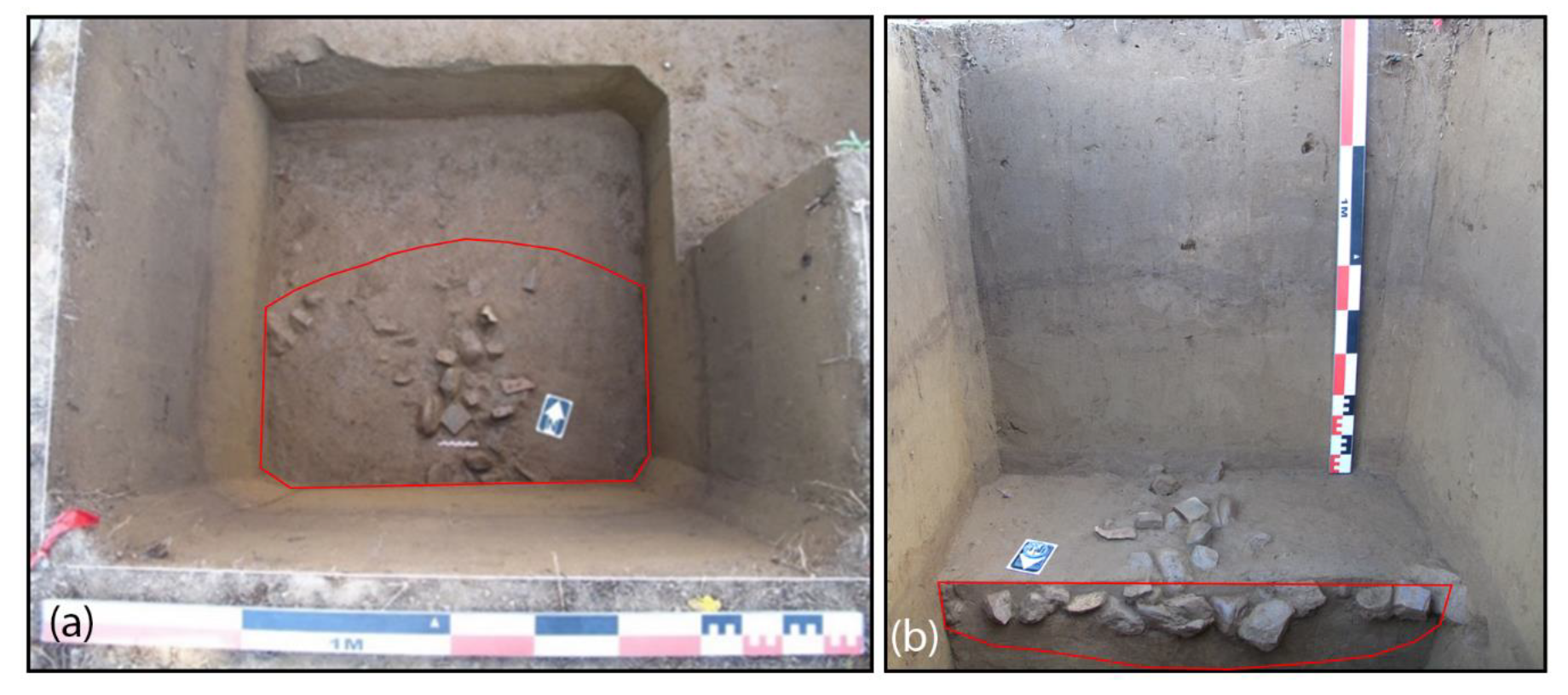
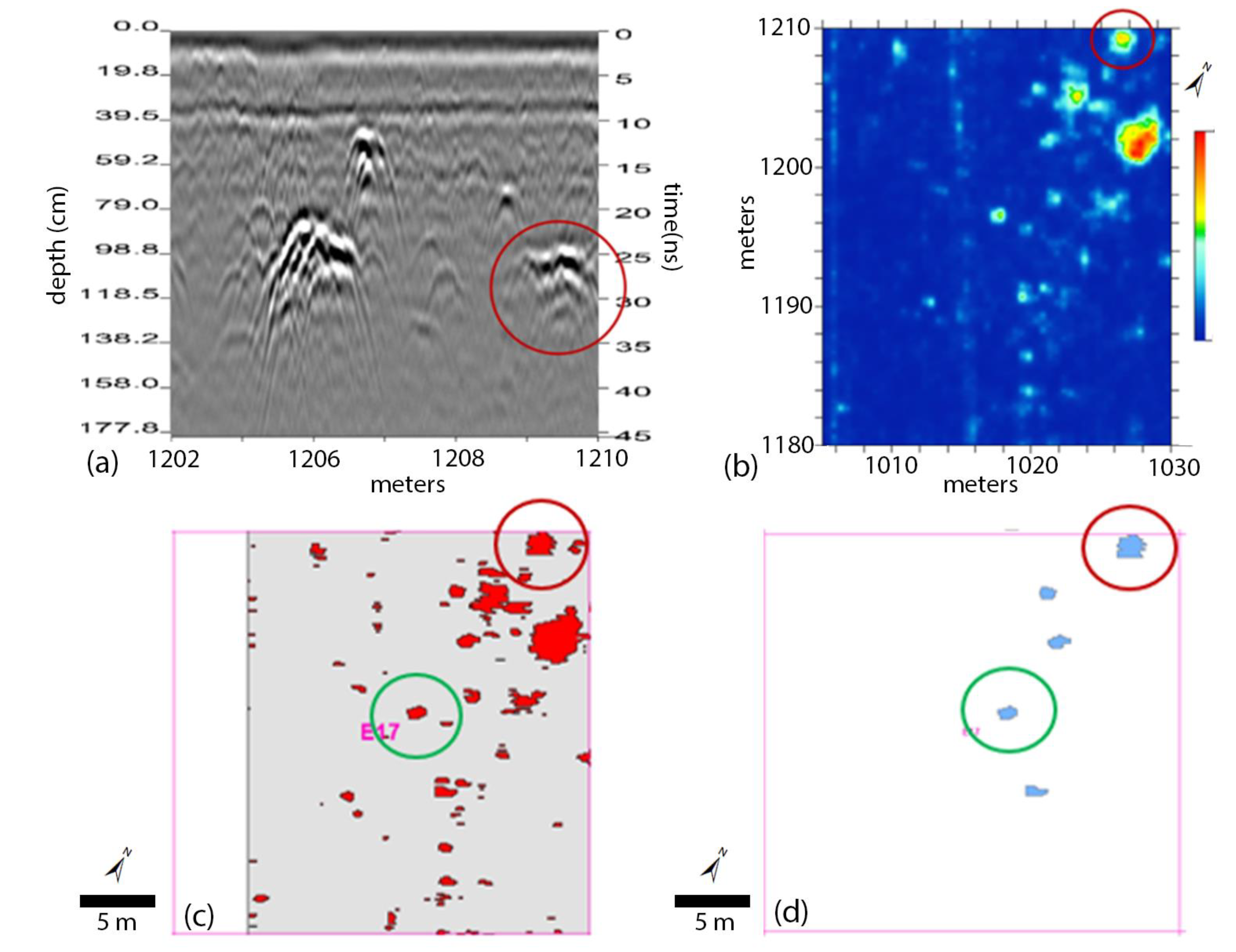
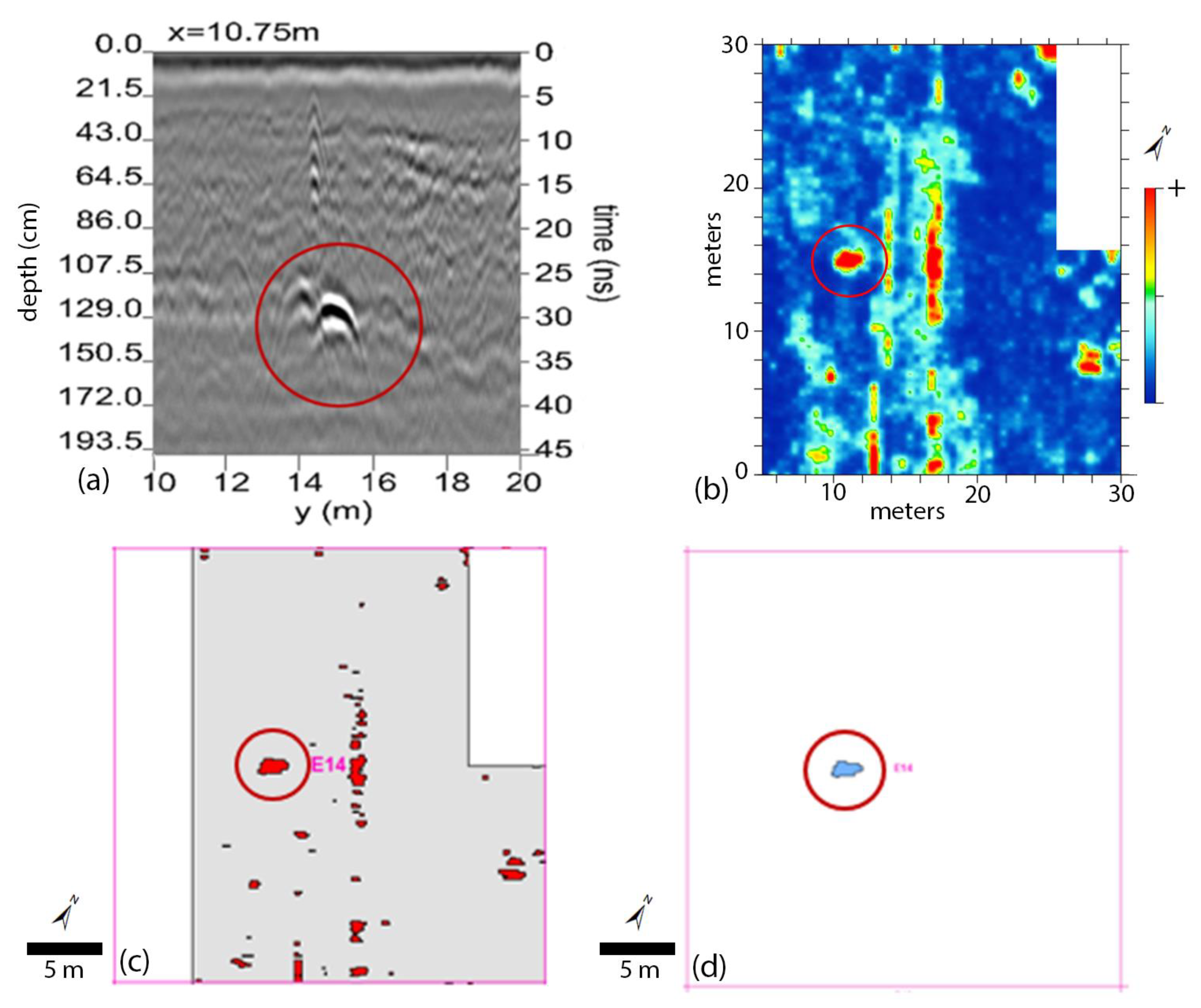
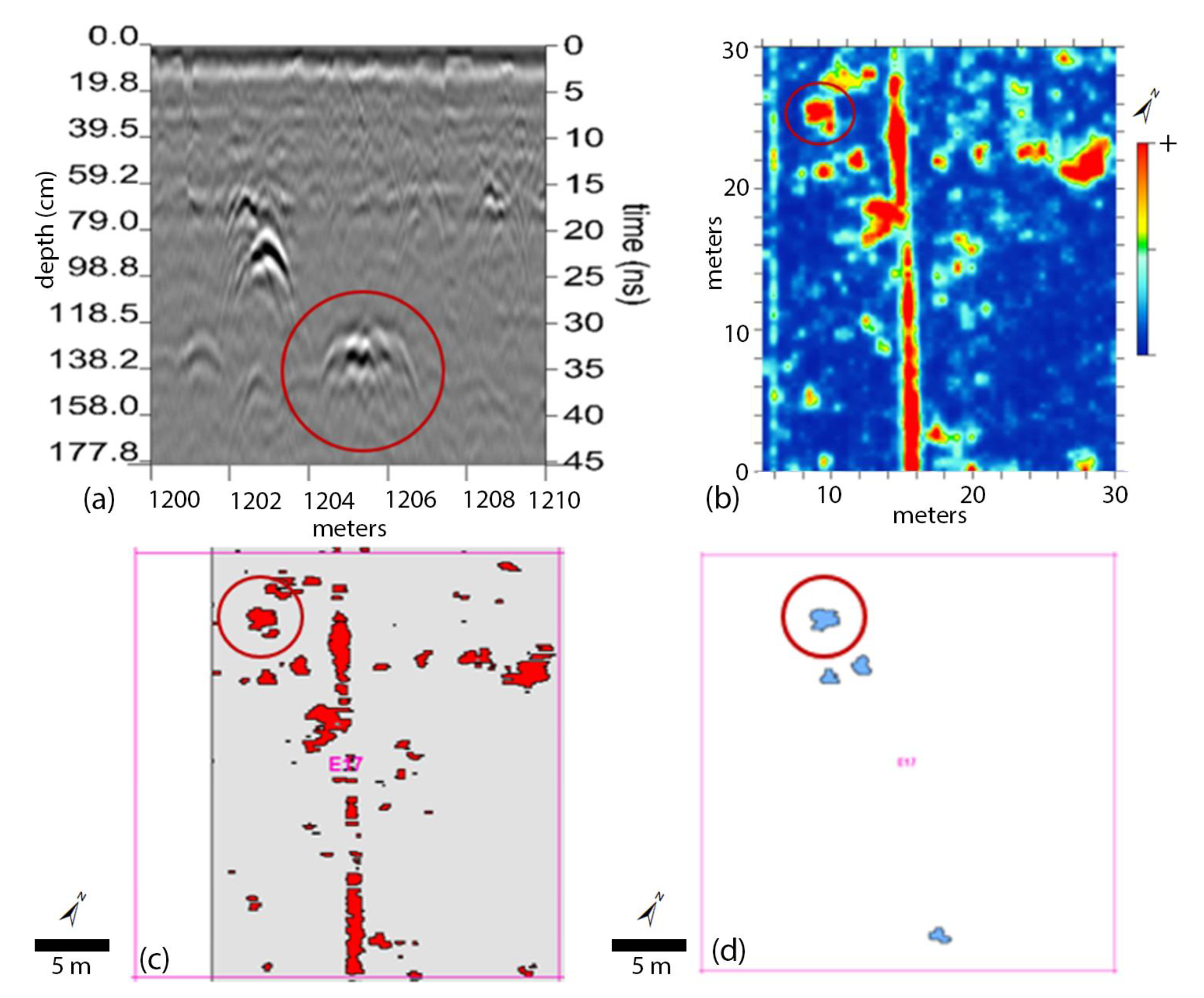
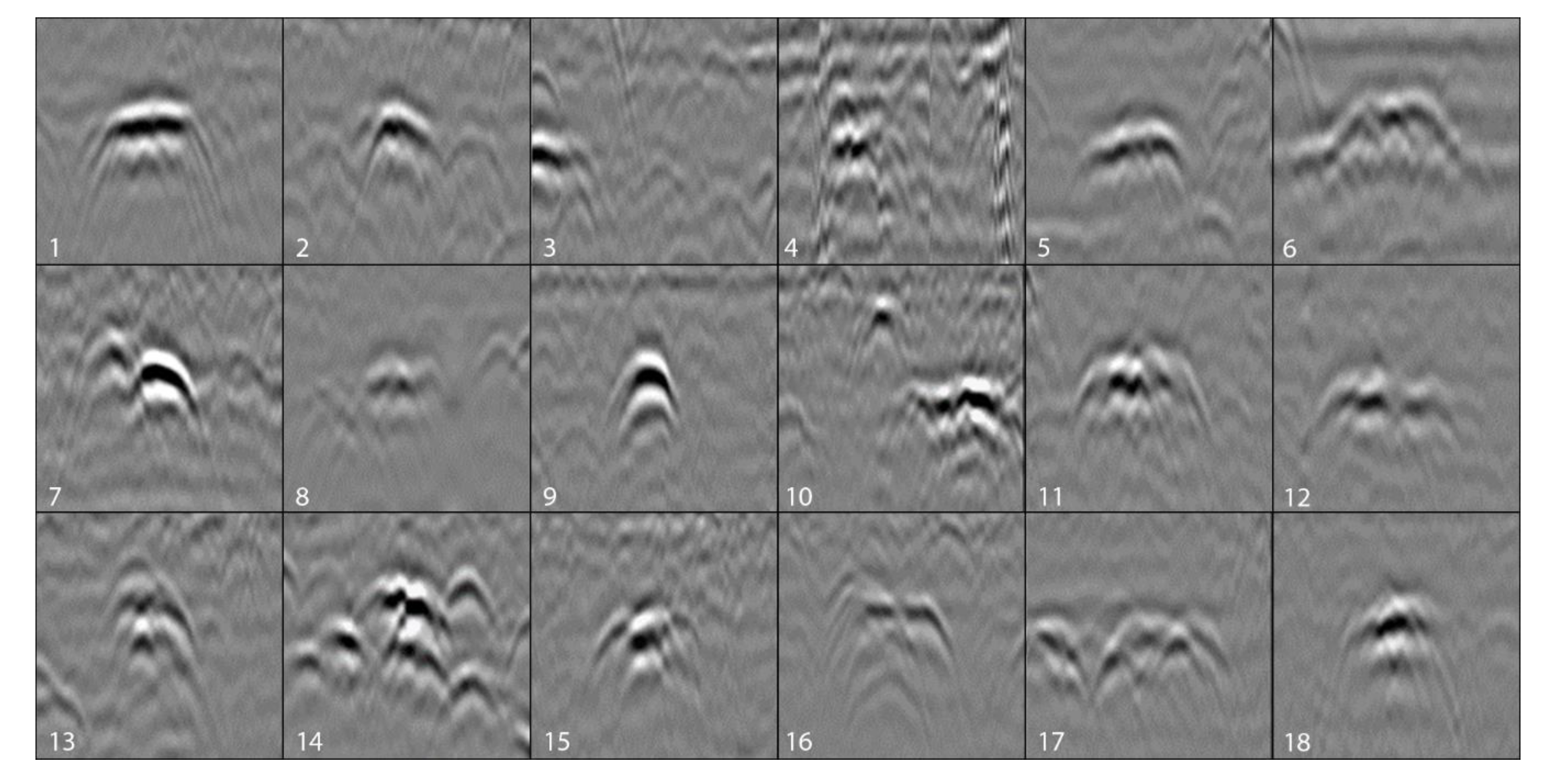
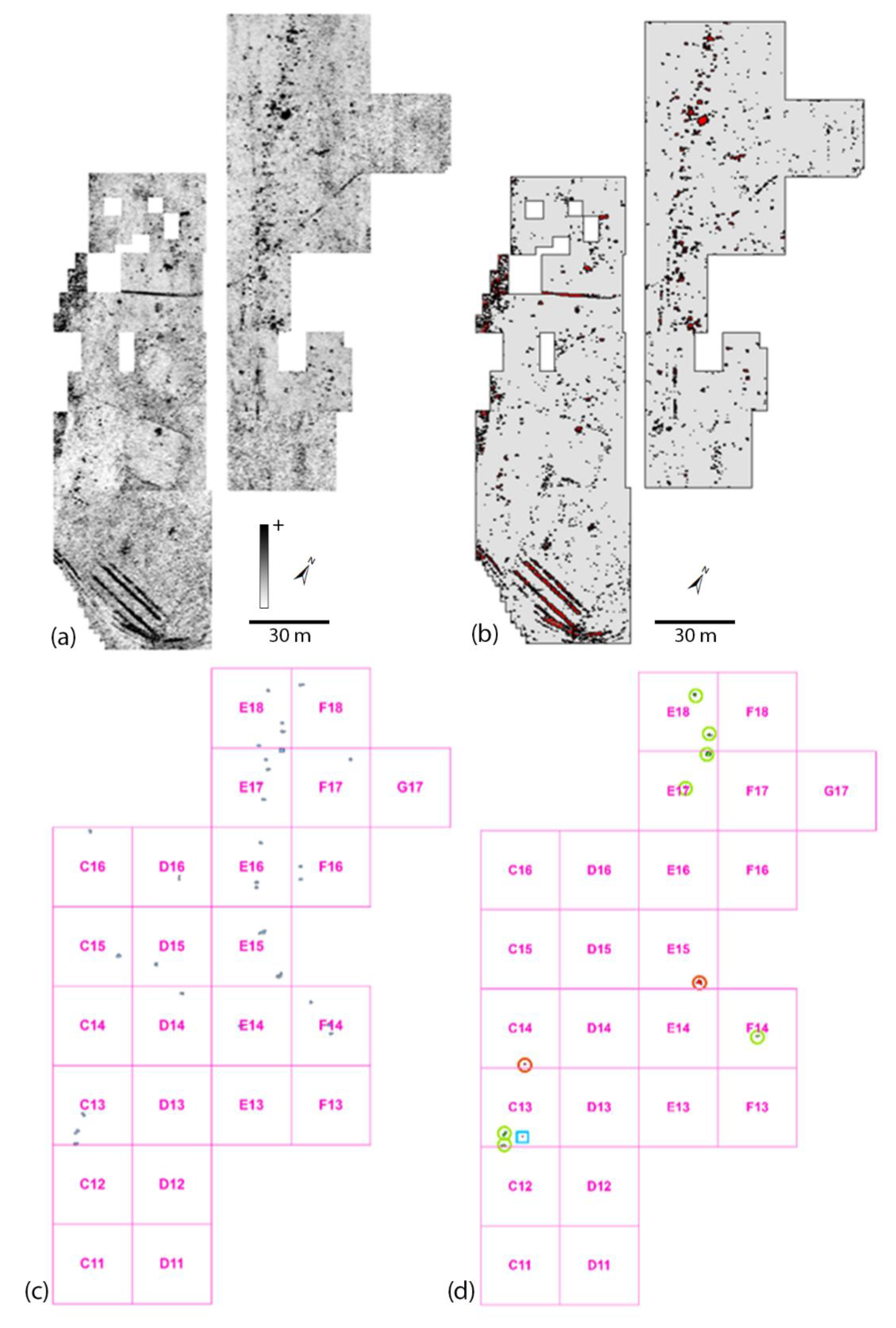
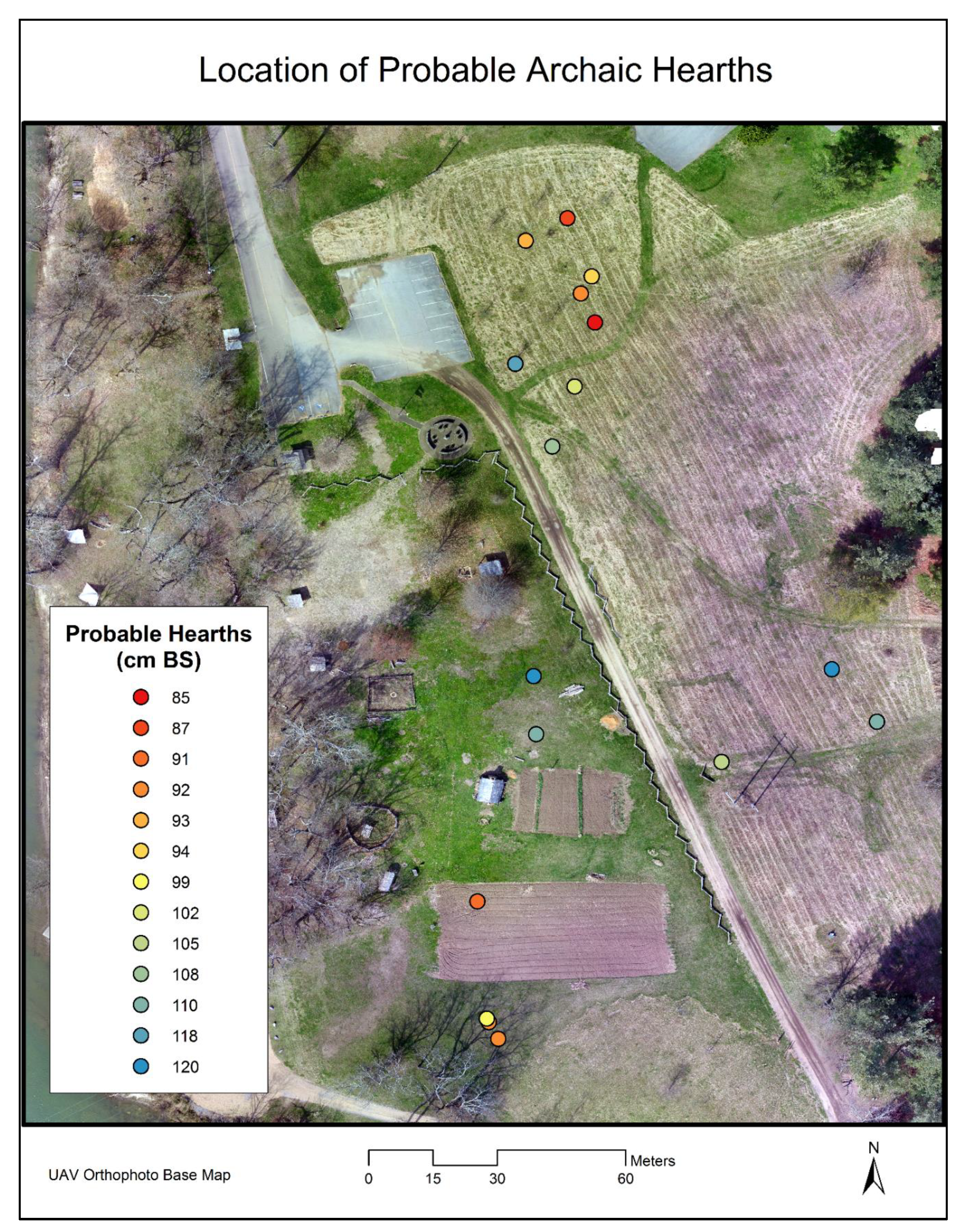
| Sample ID | Charcoal | Test Unit | Feature | Depth m BS | Uncalibrated (σ = 1) | Calibrated Range (σ = 2) |
|---|---|---|---|---|---|---|
| D-AMS 033192 | Wood | 5 | 3 | 1.02–1.20 | 8083 BP ± 40 | 7019–6832 cal BC |
| D-AMS 033776 | Wood | 36 | 10 | 0.30–0.36 | 1646 BP ± 31 | cal AD 272–534 |
| D-AMS 033773 | Wood | 46 | 13 | 0.35–0.73 | 1568 BP ± 26 | cal AD 420–550 |
| D-AMS 033775 | Wood | ET4 | 8 | 0.34–0.45 | 1534 BP ± 27 | cal AD 460–594 |
| D-AMS 033772 | River Cane | 7 | floor | 0.32 | 282 BP ± 27 | cal AD 1502–1792 |
| D-AMS 033190 | Hickory Nut | 20 | 6 | 0.32 | 280 BP ± 27 | cal AD 1599–1794 |
| D-AMS 033774 | Hickory Nut | 20 | 6 | 0.32 | 260 BP ± 24 | cal AD 1572–1799 |
| D-AMS 033191 | Wood | 4 | 2 | 0.55 | 242 BP ± 27 | cal AD 1555–1800 |
| GPR Slice Mosaic | 1. Polygons by Reclassification Threshold of 2σ | 2. Polygons by Area (> = 0.8 m2) & (< = 3.5 m2) | 3. Polygons by L2W Ratio (< = 2.5) | 4. Polygons by Circularity Index (< = 2) | 5. Modern Feature Elimination | 6. Radargram Interpretation for Auger Tests |
|---|---|---|---|---|---|---|
| 14 | 2270 | 91 | 68 | 40 | 31 | 7 |
| 15 | 2862 | 107 | 71 | 44 | 36 | 5 |
| 16 | 3212 | 199 | 91 | 53 | 39 | 6 |
| Total | 8344 | 397 | 230 | 137 | 106 | 16 (2 overlapping) |
| Probable Hearth | Test Number | Predicted m BS | Actual m BS | Predicted in Model | Tested Positive for FCR |
|---|---|---|---|---|---|
| 1 | Excavated Hearth | 1.10 | 1.02 | Yes | Yes |
| 2 | C13.S14.2/S15.1 | 0.95 | 0.92 | Yes | Yes |
| 3 | C13.S14.3/S15.2 | 1.02 | 0.92 | Yes | Yes |
| 4 | C14.S14.NM1 | 1.02 | 0.91 | No | Yes |
| 5 | D15.S16.1 | 1.20 | 1.10 | Yes | Yes |
| 6 | D15.S16.5 | 1.15 | 1.20 | Yes | Yes |
| 7 | E14.S15.1 | 1.00 | 1.05 | Yes | Yes |
| 8 | E15.S14.NM2 | 0.95 | 0.90–1.30 | No | No |
| 9 | E17.S14.2 | 0.90 | 1.02 | Yes | Yes |
| 10 | E17.S14.6 | 0.90 | 0.85 | Yes | Yes |
| 11 | E17.S16.1 | 1.12 | 1.18 | Yes | Yes |
| 12 | E17.S16.NM3 | 1.25 | 1.08 | No | Yes |
| 13 | E18.S14.2 | 0.95 | 1.02 | Yes | Yes |
| 14 | E18.S14.4 | 0.85 | 0.92 | Yes | Yes |
| 15 | E18.S15.5 | 0.90 | 0.94 | Yes | Yes |
| 16 | F14.S14.4 | 0.98 | 1.10 | Yes | Yes |
| 17 | F14.S16.3 | 1.20 | 1.20 | Yes | Yes |
| 18 | F18.S16.1 | 0.95 | 0.87 | Yes | Yes |
© 2020 by the authors. Licensee MDPI, Basel, Switzerland. This article is an open access article distributed under the terms and conditions of the Creative Commons Attribution (CC BY) license (http://creativecommons.org/licenses/by/4.0/).
Share and Cite
Cornett, R.L.; Ernenwein, E.G. Object-Based Image Analysis of Ground-Penetrating Radar Data for Archaic Hearths. Remote Sens. 2020, 12, 2539. https://doi.org/10.3390/rs12162539
Cornett RL, Ernenwein EG. Object-Based Image Analysis of Ground-Penetrating Radar Data for Archaic Hearths. Remote Sensing. 2020; 12(16):2539. https://doi.org/10.3390/rs12162539
Chicago/Turabian StyleCornett, Reagan L., and Eileen G. Ernenwein. 2020. "Object-Based Image Analysis of Ground-Penetrating Radar Data for Archaic Hearths" Remote Sensing 12, no. 16: 2539. https://doi.org/10.3390/rs12162539
APA StyleCornett, R. L., & Ernenwein, E. G. (2020). Object-Based Image Analysis of Ground-Penetrating Radar Data for Archaic Hearths. Remote Sensing, 12(16), 2539. https://doi.org/10.3390/rs12162539






